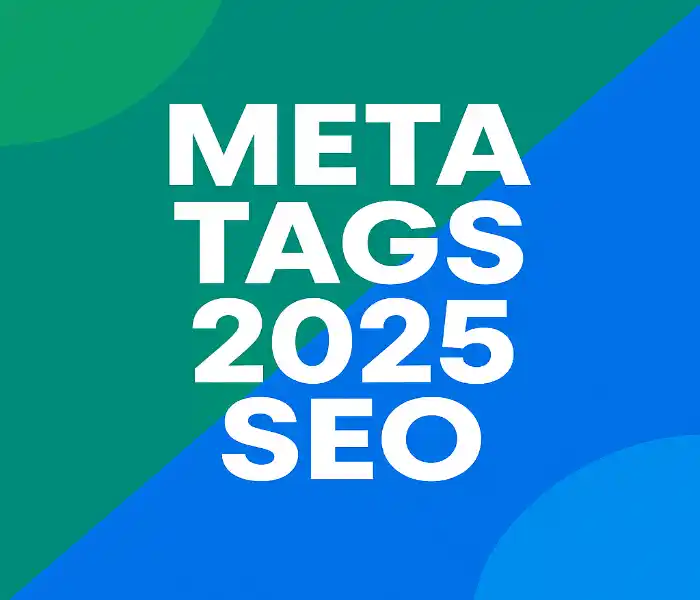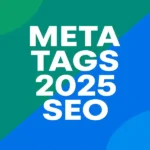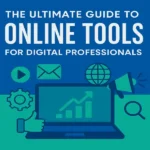If you think meta tags stopped mattering after Google scrapped meta keywords, think again.
In 2025, meta tags are the bridge between your content, Google’s AI, and user intent.
Done right, they improve click-through rate (CTR), strengthen semantic relevance, and influence how your brand appears in Search Generative Experiences (SGE).
Done wrong, they confuse algorithms and tank rankings.
Let’s break down everything you need to know to optimise meta tags for SEO in 2025.
Understanding Meta Tags in SEO
What Are Meta Tags and Why They Matter in 2025
Meta tags are snippets of HTML that tell search engines what your page is about.
They don’t appear on the page itself but in the HTML head section — quietly guiding Google’s understanding of your content.
In 2025, meta tags act as semantic signals, connecting your content with entities, intent, and topics across the web.
They influence:
- Search rankings
- SERP appearance
- Click behaviour
- Social media previews
Think of meta tags as your site’s “digital handshake” with Google.
Core Meta Tags That Impact Google Rankings
The meta tags that actually move the needle today include:
- Title tag
- Meta description
- Robots meta tag
- Viewport meta tag
- Canonical tag
- Open Graph & Twitter Card tags
Each plays a unique role in how Google crawls, understands, and displays your page.
The Evolution from Meta Keywords to Semantic Metadata
Gone are the days of “meta keywords.”
Instead, Google uses entity recognition, NLP (Natural Language Processing), and vector search to interpret your page meaning.
Your job now: create context-rich metadata that aligns with user intent and semantic entities, not just single keywords.
Google’s 2025 Perspective on Meta Tags
How Google Interprets Metadata and Context
Google’s AI doesn’t just read text; it interprets relationships between entities.
According to Google Search Central, metadata that accurately reflects page intent improves ranking stability and SGE visibility.
The algorithm analyses:
- Contextual relevance
- Clarity and uniqueness
- Entity co-occurrence (semantic SEO)
- CTR performance
Title Tags vs Meta Titles – What’s Still Relevant
There’s confusion between title tag (<title>) and meta title (<meta name="title">).
Only title tags influence rankings the meta title tag is largely ignored by Google.
Use the
<title>tag strategically with your primary keyword, semantic variation, and brand name.
Google’s Rewrite Behaviour: Why Titles Get Changed
A 2023 Zyppy study showed Google rewrote 61.6% of title tags.
Common causes:
- Overuse of separators (
|,—) - Keyword stuffing
- Titles too long (>600px) or too short (<30px)
To prevent rewrites, write titles that sound human and descriptive.
CTR and User Intent as Ranking Signals
Google’s RankBrain and SGE models consider click-through rate (CTR) as a behavioural signal.
If your meta title and description attract clicks your ranking can rise even without new backlinks.
Essential Meta Tags for SEO in 2025
Title Tags – Writing for Humans and Algorithms
Your title tag remains the strongest meta signal.
Best practices:
- Keep under 60 characters or 600 pixels
- Place your primary keyword first
- Add brand name at the end (optional)
- Use dashes (-) instead of pipes (|)
- Sound natural avoid robotic phrasing
Example:
✅ Meta Tags in 2025 – The Future of SEO Optimization
❌ Meta Tags | SEO | 2025 | Best Practices
Meta Descriptions That Boost Click-Through Rates
Meta descriptions don’t directly affect rankings but they drive CTR.
Write them like mini-advertisements:
- 130–155 characters max
- Include a call-to-action
- Reflect the page’s actual content
- Use active voice
Example:
Learn the essential meta tags for SEO in 2025. Improve CTR, rankings, and brand visibility with proven on-page strategies.
Use Meta Tag SERP Preview Tool or Yoast SEO in WordPress to check snippet display.
Robots Meta Tag – Crawl and Index Control
The robots tag manages how search engines interact with your content:
<meta name="robots" content="index, follow">Options include:
noindex– prevent indexingnofollow– stop link equity flownosnippet– hide description in SERPs
Use tools like Rank Math to automate page-level crawl control.
Viewport Meta Tag – Mobile-First Indexing and UX
Mobile-first indexing is no longer optional.
Without a proper viewport tag, your site’s layout breaks on mobile.
Example:
<meta name="viewport" content="width=device-width, initial-scale=1">Canonical Tags – Preventing Duplicate Content
Canonical tags signal the “master” version of a page.
<link rel="canonical" href="https://example.com/original-page">They prevent duplicate content issues, especially on eCommerce and CMS-driven sites.
Open Graph and Twitter Card Tags – Social SEO Benefits
Social metadata influences clickability and share previews.
Open Graph (Facebook, LinkedIn):
<meta property="og:title" content="Meta Tags 2025 SEO Guide"> <meta property="og:description" content="Learn the essential meta tags for SEO in 2025."> <meta property="og:image" content="https://example.com/meta-tags-2025.jpg">Twitter Card Example:
<meta name="twitter:card" content="summary_large_image">These improve engagement metrics indirectly boosting your SEO visibility.
Schema Markup (Product, FAQ, Review, How-To)
Structured data gives you rich snippets enhancing visibility in SERPs.
Use schema types relevant to your page:
- Product schema – eCommerce items
- FAQ schema – questions and answers
- Review schema – ratings
- How-to schema – step-by-step tutorials
JSON-LD Implementation for Rich Snippets
Google recommends JSON-LD format for all structured data:
<script type="application/ld+json"> { "@context": "https://schema.org", "@type": "FAQPage", "mainEntity": [{ "question": "Are meta tags still important in 2025?", "acceptedAnswer": {"text": "Yes, they remain key for context, SERP visibility, and AI-driven ranking signals."} }] } </script>Use Google’s Schema Validator or Ahrefs Site Audit to test errors.
AI and Entity-Based Optimization in Metadata
Modern SEO is entity-first.
Integrate terms that connect with Knowledge Graph entities (brands, tools, people, places).
Use SurferSEO or MarketMuse for entity suggestions.
How Structured Data Enhances SERP Visibility
Rich snippets can increase CTR by up to 35% (Moz, 2024).
They help your site appear in:
- FAQ dropdowns
- Review stars
- How-to carousels
- Google SGE summaries
Writing Effective Meta Titles in 2025
Ideal Title Tag Length (Pixels vs Characters)
Google measures title width in pixels, not characters.
Aim for 51–55 characters or under 600px to avoid truncation.
Keyword Placement – Primary vs Secondary Terms
Put your main keyword first, then a secondary variation, followed by your brand.
Example:
Meta Tags 2025 SEO Tips – Rank Higher with Smart Metadata | YourBrand
Avoiding Keyword Stuffing and Cannibalisation
Repeating similar terms confuses Google’s NLP.
Stick to 1–2 keyword variations per title.
Avoid having multiple pages target the same intent.
Use of Numbers, Brackets, and Separators for Engagement
Odd numbers perform 20% better in CTR tests (Zyppy, 2024).
Example:
✅ 7 Proven Meta Tag Strategies for SEO in 2025
Avoid brackets Google often strips them during rewriting.
Mobile-First and Visual Search Optimization
Responsive Metadata for All Devices
Your metadata must look clean across devices.
Use SERP snippet tools to preview desktop vs mobile.
Remember, over 60% of searches happen on mobile (StatCounter, 2024).
Emojis and Visual Elements in Title Tags – When to Use Them
Google filters out irrelevant emojis but may show contextually relevant ones.
Example: “Best Headphones 🎧 in 2025” can improve CTR if relevant to user intent.
Testing Title Display Across Mobile and Desktop SERPs
Perform A/B testing using Google Search Console Experiments or tools like Thruuu and Marketingusaagency.com.
Common Meta Tag Mistakes to Avoid
- Using outdated tags like meta keywords, author, or generator
- Duplicating titles and descriptions across pages
- Ignoring structured data validation
- Overusing separators or capitalisation
- Skipping mobile snippet testing
Measuring Meta Tag Performance
Using A/B Testing to Compare Title and Description CTR
Test variations with tools like SEOTesting, Google Optimize, or Rank Math Analytics.
Track CTR changes over 30 days to validate improvements.
Monitoring Rewrite Frequency with Tools Like Zyppy
Zyppy’s 2024 title rewrite tracker shows which pages Google modifies most often a great indicator of title quality.
Interpreting Engagement and Conversion Data
Combine metrics:
- CTR (Google Search Console)
- Bounce rate (GA4)
- Conversion rate (CRM or Analytics tools)
Use data-driven decisions to evolve your metadata continuously.
Future of Meta Tags and Semantic SEO
Entity-Based Search and Knowledge Graph Optimization
Google’s Knowledge Graph now powers entity-based indexing.
Optimise your metadata around recognised entities: brands, tools, industries, and topics.
Use Wikidata, Google’s NLP API, or SurferSEO’s audit feature for entity extraction.
AI-Driven Metadata and Search Generative Experience
In 2025, SGE (Search Generative Experience) surfaces content summaries directly on SERPs.
Metadata influences how your content is pulled into these AI-generated snippets.
Voice and Multimodal Search Implications for Metadata
Voice search relies on concise, descriptive metadata.
Include conversational keywords (“how to”, “what is”, “best way to”).
Multimodal search (images + text) uses metadata like alt text, og:image, and JSON-LD structured data.
Preparing for Google’s Next SEO Algorithm Shift
Focus on:
- Entity consistency across metadata
- Contextual depth (semantic clusters)
- User engagement signals
- Continuous A/B testing and validation
Conclusion – Crafting Metadata That Ranks and Converts
Meta tags aren’t dead they’ve evolved.
In 2025, they’re the connective tissue between your content, AI-driven search, and human behaviour.
To win:
- Write for people first, search engines second.
- Validate your metadata with schema and testing tools.
- Monitor performance and iterate monthly.
Every click begins with a meta tag.
Make yours worth clicking.
FAQs
1. Are meta tags still important for SEO in 2025?
Yes. They remain essential for communicating context to search engines and improving CTR in both traditional and AI-driven SERPs.
2. How long should a title tag be in 2025?
Keep it under 60 characters or 600px. Use SurferSEO or Yoast for preview testing.
3. Do meta descriptions affect rankings?
Not directly, but they strongly influence CTR and engagement — which indirectly boost rankings.
4. What’s the difference between meta title and title tag?<title> impacts SEO and SERP titles. <meta name="title"> is mostly ignored by Google.
5. Which schema markup types are best for SEO in 2025?
Use FAQ, Product, Review, and HowTo schemas. They drive rich results and enhance entity-based optimisation.
6. How often should I audit meta tags?
At least once every quarter. Use tools like Rank Math, Ahrefs, or Semrush to automate audits.




